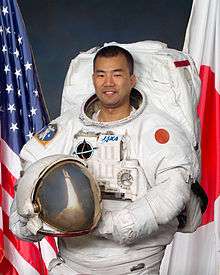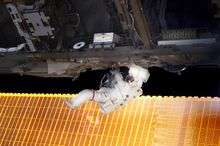Soichi Noguchi
| Soichi Noguchi | |
|---|---|
 | |
| NASDA/JAXA Astronaut | |
| Nationality | Japanese |
| Born |
April 15, 1965 Yokohama, Japan |
Other occupation | Engineer |
Time in space | 177d 3h 5min |
| Selection | 1996 NASDA Group |
| Missions | STS-114, Soyuz TMA-17 (Expedition 22/23) |
Mission insignia |
|
Soichi Noguchi (野口 聡一 Noguchi Sōichi, born 15 April 1965 in Yokohama, Japan) is a Japanese aeronautical engineer and JAXA astronaut. His first spaceflight was as a Mission Specialist aboard STS-114 on 26 July 2005 for NASA's first "return to flight" Space Shuttle mission after the Columbia disaster. He was most recently in space as part of the Soyuz TMA-17 crew and Expedition 22 to the International Space Station (ISS), returning to Earth on 2 June 2010. He is the fifth Japanese astronaut to fly in space and the fourth to fly on the space shuttle.
Personal life
Soichi Noguchi was born in 1965 in Yokohama, Japan. He considers Chigasaki, Japan, to be his hometown. He holds flight instructor certificate as CFII and MEI. Noguchi was a Boy Scout.[1][2][3] He is married and has three children.[4] His hobbies include jogging, basketball, skiing and camping.[5]
Education
Noguchi graduated from Chigasaki-Hokuryo High School in 1984, and then studied at the University of Tokyo, earning a bachelor's degree in 1989 and a master's degree in 1991, both in Aeronautical Engineering.[6]
Engineering career


After graduation, Noguchi worked for Ishikawajima-Harima Heavy Industries, assigned to the research and development department of their Aero-Engine and Space Operations division. He worked on aerodynamic design of commercial engines.[6]
Astronaut career
Noguchi was selected as an astronaut candidate by the National Space Development Agency of Japan (now part of JAXA) in June 1996. In August 1996, he reported to NASA's Johnson Space Center for NASA astronaut training. Noguchi qualified as a mission specialist after two years, and received training on Russian space systems at Gagarin Cosmonaut Training Center in 1998. He was assigned to technical support for the Japanese Experiment Module of the International Space Station and then, in April 2001, to the crew of STS-114 as a Mission Specialist.
Noguchi flew to the ISS on Soyuz TMA-17 on 20 December 2009. He served as a primary crew member (as Flight Engineer) of Expedition 22 and Expedition 23.[6] While in space, he took many photographs of Earth which he shared via Twitter. He returned to Earth on 2 June 2010.
In 2017, he was selected as the Flight Engineer for the Expedition 62 / 63 crew, to be launched near the end of 2019.[7]
Other highlights
Noguchi voices himself in episodes 13 and 26 of the anime series Uchū Kyōdai (Space Brothers), which aired on 24 June 2012 and 29 September 2012 respectively.[8]
On 2 August 2015, Noguchi spoke to 33,628 fellow Scouts during the Arena Event at the 23rd World Scout Jamboree, held in Japan.
References
![]()
- ↑ Amiko Nevills (2005-03-31). "STS-114 Mission Specialist Soichi Noguchi: Teaming up to Return to Flight, Scout's Honor". NASA. Retrieved 2008-01-21.
- ↑ "General Mission Debriefing by Astronaut Soichi Noguchi". 2005-10-01. Retrieved 2008-01-21.
- ↑ "Preflight Interview: Soichi Noguchi". NASA. Retrieved 2008-01-21.
- ↑ Amit Asaravala (2005-07-08). "The Crew of Flight STS-114". Wired. Retrieved 2008-01-21.
- ↑ "Biographies of International Astronauts-Noguchi Soichi Japan". Spacefacts. 2007-12-30. Retrieved 2008-01-21.
- 1 2 3 "Astronaut Bio: Soichi Noguchi (5/2008)". NASA. Retrieved 2009-09-09.
- ↑ "JAXA Astronaut Soichi Noguchi Selected as a Member of ISS Expedition Crew". JAXA. 7 November 2017. Retrieved 7 November 2017.
- ↑ Ransom, Ko (2012-05-12). "Astronaut/Yamato Fan Noguchi Plays Himself in Space Brothers". Anime News Network. Retrieved 2017-10-28.